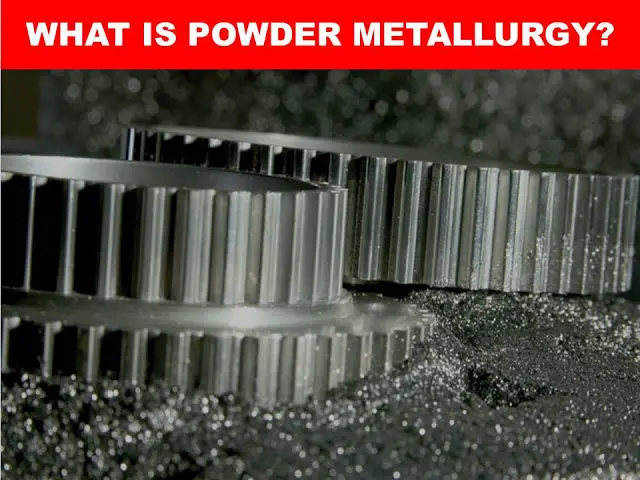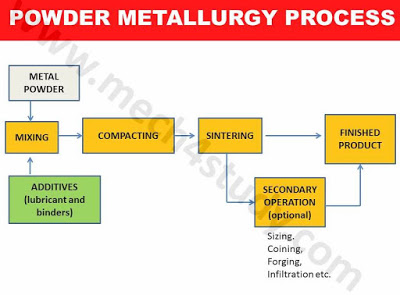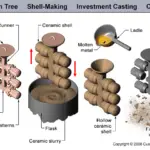Powder Metallurgy or P/M is a manufacturing process of producing finished or semi-finished objects by compressing the metal powder into suitable dies. It is one of the cheapest process which gives high quality, high strength, complex shapes with high degree of accuracy. These factors make this process most suitable for mass production. It mainly involves four basic steps.
1. Powder Preparation:
2. Mixing and Blending:
3. Compacting:
4. Sintering:
Sometimes, this process accomplished with some secondary operation like sizing, coining, infiltration, hot forging etc.
Powder metallurgy is continuously growing technology. Almost all metals can cast by P/M technology but mostly iron powder is used with some alloying elements like copper, graphite which gives greater strength.
Learn more about this process with its pros and cons in this article.
Powder Metallurgy Process:
As we discussed earlier, P/M involves basic four processes. These are:
1. Powder Preparation:
This is first and basic step for producing any object by powder metallurgy process. Any material can convert into powder. There are various processes of producing powder such as atomization, grinding, chemical reaction, electrolysis process etc.
2. Mixing and Blending:
As the name implies, this step involves mixing of two or more material powder to produce a high strength alloy material according to the product requirement. This process ensure even distribution of powder with additives, binders etc. Sometime lubricants also added in the blending process to improve flow characteristic of powder.
3. Compacting:
Compacting means compressed the prepared powder mixture into pre-defined dies. This step ensures to reduce voids and increase density of the product. The powder is compacted into mould by the application of pressure to form a product which is called green compact (the product get by compacting). It involves pressure range from 80 to 1600 MPa. This pressure depends on the properties of metal powder and binders.
For soft powder compacting pressure is about 100 – 350 MPa.
For steel , iron etc. the pressure is in between 400 – 700 MPa.
4. Sintering:
The green compact, produced by compressing, is not very strong and can’t be used as final product. This step involves heating of green compact at an elevated temperature which ensure permanent strong bond between adjacent particles. This process provides strength to green compact and converts it into final product. The sintering temperature is generally about 70 to 90 percent of melting temperature of metal powder.
5. Secondary Operation
The sintered object is more porous compare to fully dense material. The density of product depends upon press capacity, sintering temperature, compressing pressure etc. Sometimes, the product does not require high density and the sintered product is directly used as final product. But sometimes, a highly dense product is required (for example manufacturing bearing etc.) where sintered product cannot be used as finished product. That’s why a secondary operation required to obtain high density and high dimensional accuracy. The most common secondary operation used are sizing, hot forging, coining, infiltration, impregnation etc.
Advantages and Disadvantages:
Advantages:
- P/M is Cost effective for mass production due to absence of labour cost, further machining cost etc.
- This process does not require high skilled operator.
- Some alloys can only produce by P/M technology.
- High production rate. It can produced 500 to 1000 pieces in one hour.
- Complex Shape can produce.
- Bimetallic and laminated product can be easily produced by P/M method.
Disadvantages:
- High equipment cost.
- It is economical only for mass production.
- Intricate designs is difficult to produce due to less flow ability of metal powder.
- It cannot produce a complete uniform dense product.
- Size of the product is restricted due to capacity of press.
- Some metals powder, which can produce explosion in powder form, cannot be used.
- Low impact and fatigue property of final product.
- It is difficult to cast low melting point metals by P/M technology.
Application:
- Cutting tools like cemented carbide tool, ceramic tool etc. are Powder metallurgy product.
- Electric bushes made by mixing Cu and Ag with graphite is P/M product.
- Nozzles for rocket and missiles.
- Small parts in automotive and appliance applications where the ability to produce a nearly final shape requiring a minimum machining, provides a strong economic advantage.
- Bearing, Bushes etc.
- Magnetic soft metals like Fe, Fe-3Si etc. can easily formed into final shape by P/M.
This is all about powder metallurgy process with its advantages and disadvantages. If you have any query regarding this article, ask by commenting. If you like this article, don’t forget to share it on social networks. Subscribe our website for more informative articles. Thanks for reading it.





Dear Sir:
Good day. this is Robin from China, we are the professional manufacturer for Industrial Brushes, like Wheel brush, Disc brush, Tube brush, , Cup brush, and other kinds of brushing used for polishing, deburring and so on .
Wish we can enjoy business in powder metallurgy line
Any question, please feel free to let us know .
Thanks and regards
Robin
Dear sir.
This zammali Abdelkader from tunisia .je suis entrain d’étudier l’implantation d’usine de fabrication des pieces par poudre metalique.Merci de me contacter afin de voir les specification technique et les ligne de fabrication.
Cordialy
Please give some detail about secondary operations and also its application bushes and bearing..overall you give us a extremely good info about P/M thanku
Thank you so much for all this information, may I have some types of products that can be produced, by the powder metallurgy process.